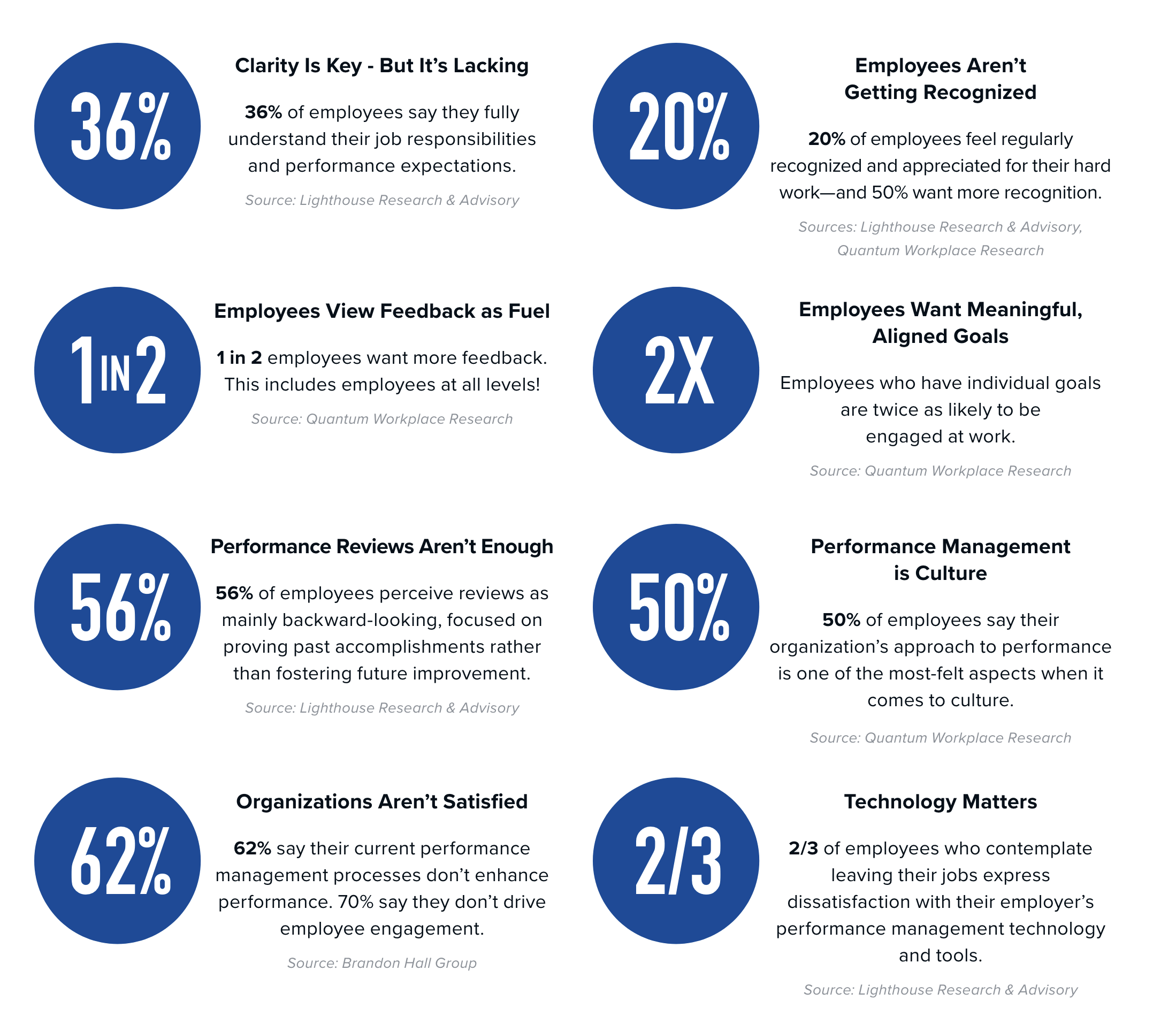By embracing continuous performance management, organizations can foster a culture of real-time feedback and development, ensuring every step an employee takes is a step forward for the company.

Imagine a team where the coach only gives feedback at the end of the season. The players, brimming with potential, would navigate game after game without direction. Missteps would go uncorrected and triumphs uncelebrated until it was too late to make a meaningful difference. This scenario mirrors the traditional annual performance review cycle.
Employees journey through the year, tackling projects, facing challenges, and celebrating victories—all in the absence of timely guidance. This outdated approach not only stifles individual growth and motivation. It obscures the crucial alignment between each employee's efforts and the overarching goals of the team and company.
By embracing continuous performance management, organizations can foster a culture of real-time feedback and development, ensuring every step an employee takes is a step forward for the company.
Continuous performance management is a modern approach to managing employee performance. It's focused on ongoing communication and feedback between managers and employees, positioning managers as performance coaches. Continuous performance management is a departure from the traditional annual performance review. Research shows this approach is more effective and engaging, benefiting both employee and business success.
Continuous performance management is key for many reasons. It helps employees grow, motivates better performance, and expedites business outcomes. It recognizes that employees thrive when they feel valued, heard, and supported at work. Continuous performance management also helps workplaces stay agile amidst rapid change, increased competition, and evolving employee expectations.
Research shows employees prefer continuous performance management over the annual performance review—and that it impacts both engagement and retention.

A continuous approach to performance is empowering for employees and essential for success. Managers can give timely feedback and address roadblocks as they occur. They can partner with employees to outline development opportunities and align on goals. They can recognize great work as it happens, instead of waiting for the annual review. Consistent dialogue around performance creates a foundation of trust, clarity, and motivation. It makes all the difference in employee growth and your bottom line.
Continuous performance management benefits many different components of your organization. These include:
Your continuous performance management program should incorporate a web of integrated performance activities. These activities should work together to boost employee and business success.
At the heart of these activities is regular 1-on-1s between managers and employees. Establishing a rhythm for regular check-ins is essential for continuous feedback and coaching. Here is what we recommend to our customers:
Continuous feedback and recognition keep your performance management flywheel spinning smoothly. Feedback keeps your teams and initiatives vibrant and informed. It should come in many different forms like project feedback, peer feedback, or customer feedback. A continual stream of thoughtful feedback helps employees keep a 360-view of their performance. Real-time recognition helps nurture a culture of appreciation and motivation. It helps employees feel valued and motivates them to do their best work.
To implement continuous performance management, you need executive buy-in, equipped teams, and the right technology. After years of leaning on the annual performance review, your executives may not understand the importance of a continuous approach. Your managers might be resistant or feel unequipped to facilitate the process.
Getting your leadership team aligned is a critical first step in developing an effective performance management strategy. It's not just about agreeing on a strategy; it's about active engagement and understanding impact. What does the organization want to achieve with its performance management activities? What systems and tactics will best align with the organization's mission, vision, values, and goals?
Leadership buy-in transforms continuous performance management from a concept into a cultural pillar. It ensures a unified approach to enhancing performance and engagement.
Once you have alignment, you need clear goals and a structure to guide you. This includes deciding on key practices like the frequency of performance reviews, how to orchestrate feedback, and how to set and track goals.
Regular 1-on-1 meetings should be foundational to your approach. Managers and employees can use these sessions to track progress, tackle obstacles, and adjust goals. Conversations should feel straightforward and supportive. You want to encourage constructive dialogue, blending praise with actionable insight for improvement.
To implement continuous performance management effectively:
By articulating your goals and framework clearly, you can ensure your program is implemented well. The clarity you provide will equip your managers and employees to participate effectively, enhancing the likelihood of success.
For a smooth transition, it's crucial to equip your teams with the right knowledge and skills. Everyone should understand how to exchange feedback constructively, set and track goals effectively, and engage in meaningful 1-on-1 conversations.
Help your managers run relaxed yet impactful performance conversations. They should encourage two-way feedback that builds trust and drives better results. Provide your managers with continuous support that helps them adapt to new scenarios confidently. Continue to communicate what's most important to the larger organization.
For employees, help them understand how the system works and their role in the process. When should they ask for feedback and how? What does goal-setting look like? What does the annual performance management cycle look like and what can they expect at each step?
Training your teams sets the foundation for successful implementation and adoption across the organization.
Your job is not over once your program is launched. Continuous performance management is not a destination, but a journey. Capture ongoing feedback from your leaders, managers, on employees on how things are going. Are people getting value out of the system as a whole and the activities within it? Do they feel the process is easy to navigate? Are they spending too much time on administration? How do they feel about the tools you've deployed?
Use the feedback you're gathering to make ongoing optimizations to the program.
Pen and paper (or dozens of spreadsheets) is not the way to facilitate continuous performance management—or any performance management process for that matter. Effective performance management software can reduce administrative burden for HR, streamline coaching practices, and boost team performance.
A performance management platform helps HR and people leaders automate and centralize every step of the process. When goals, feedback, and documentation are all in one place, it's easier for managers and employees to track progress and discuss performance.
Performance management software also promotes data-driven decisions. When you're capturing and analyzing real-time performance data in a visible and accessible way, you get better insights for talent decisions. This includes training needs, promotions, retention priorities, and more.
Your platform should empower employees to do their best work day in and day out. Look for these features when shopping around for the right software:
Performance reviews are the summative anchor of all performance activities throughout the year. They serve as an valuable opportunity to reflect on successes and areas of growth for the coming year. Your performance management platform should help automate and streamline your performance review process and make it easy for managers and employees to collaborate and document and the conversation.
Goals help employees and teams set, track, and accomplish aligned business outcomes. This tool will boost employee accountability to ensure goals are reached. Look for features like cascading goals, AI-powered goal ideas, flexible formatting, and admin-friendly organization.
1-on-1s help facilitate employee-manager conversations that are key to performance. Regular performance and development conversations increase trust, accountability, and employee success. Features to prioritize include access to best practice and customizable templates, automated cycles, usage analytics, and the ability to pull in data from goals and feedback.
Feedback tools help employees and managers ask for and receive impactful feedback. The right tool will boost trust and performance in a simple, streamlined manner. Look for flexible feedback frameworks, AI-powered feedback assistance, automated-cycles, and the ability to create culture-approved templates.
Recognition elevates employee success across the entire organization. With this tool, you can celebrate employees for their achievements and encourage good habits in the future. Features to look for include a peer-to-peer recognition newsfeed, the ability to tie recognition to goals and core values, and analytics that help you see how is getting recognized, how often, and for what.
Talent reviews help leaders understand the overall state of their talent. With the right tool, you can elevate top performers and talent risk—all in one place—to make strategic decisions about your workforce. Look for features like simple manager feedback requests, talent pool visualization and retention flags, review calibration, and connection to succession planning.
Succession planning helps your organization continuously and proactively identify successors and create development plans that keep your organization on a path to success. Look for tools that help you flag gaps, track candidate performance and readiness, develop your successors, and share board-ready succession plans when you need them.
Here are a few other elements to prioritize when choosing performance management solutions:
To determine whether your approach is measuring up, keep a pulse on employee progress and outcomes. If your employees aren't meeting expectations or growing in their roles, you may need to make changes in your approach.
Gathering employee feedback is another way to gain the insight you need. Ask employees directly how they feel about the coaching they receive. Decide which practices to stop, start, or continue. Help managers understand how to individualize their coaching.
Don't forget to keep your managers at the center. Managers are biggest driver of employee engagement. They're in the best position to bolster it in a way that drives performance.
Implementing a new performance management system can feel like a daunting task, but remember, you don't need to revolutionize your entire approach overnight. Success lies in gradual progress and mindful change management.
Start by identifying your organization's most pressing needs. Prioritize them and focus on your top priority first. Define the desired behaviors, set goals, and leverage platform features to lay the foundation.
As you achieve your initial goals, expand your efforts to incorporate deeper capabilities. Gather feedback from users to optimize your strategies. The aim is to solidify the behaviors you've set out to establish.
Don't stop at your initial priorities if you're meeting your goals. Move on to the next item on your list and repeat the process. As you add features and capabilities, consider how to leverage the wealth of data at your disposal for insightful analysis.
Embracing continuous performance management transforms how we support and develop our teams. Move beyond the annual review to provide regular feedback and growth opportunities for everyone, from top performers to those who need more guidance. Implement your program with clear goals, leadership support, and ongoing training. By fostering an environment of open communication and timely feedback, we not only boost employee engagement. We are able to align everyone around your organization's most important work. This doesn’t just improve performance; it builds a culture where every employee feels valued and motivated to contribute to our shared success.
Quantum Workplace's performance management platform helps you build more effective managers and teams through continuous performance management. Learn more!
Published March 27, 2024 | Written By Kristin Ryba